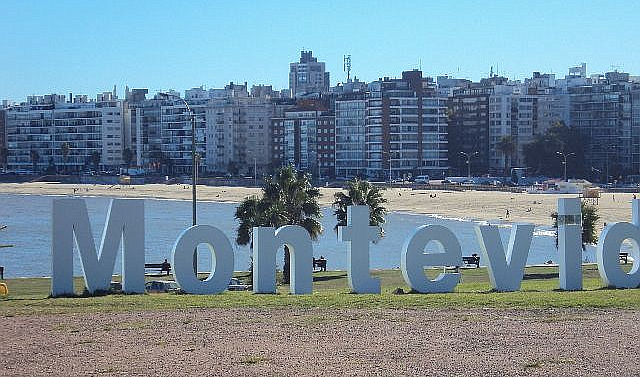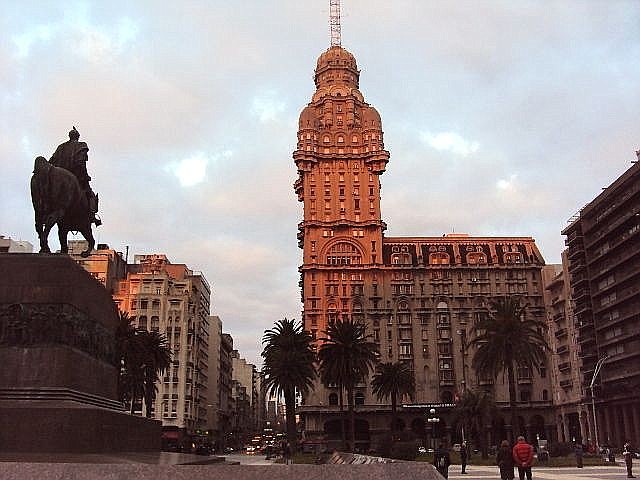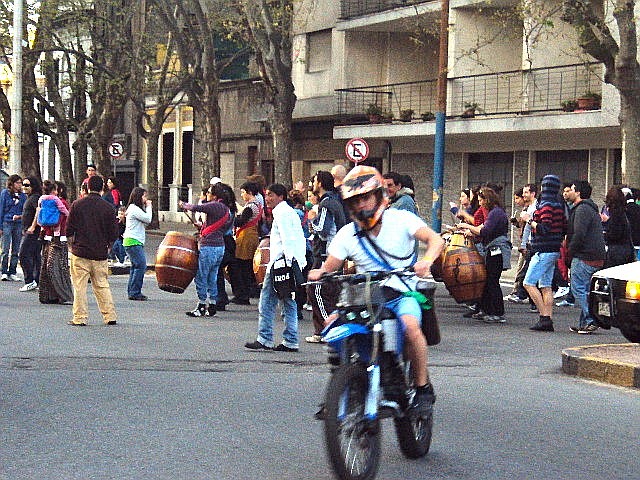 Facebook
Facebook
 X
X
 Instagram
Instagram
 TikTok
TikTok
 Youtube
Youtube

The capital and only major city of Uruguay doesn't get the acclaim of some neighbors – notably Buenos Aires and Punta del Este – but it's a vibrant and fascinating place, and if time is short, it's good to have a plan. Since most international flights arrive early in the morning, let's map out the best use of that two days and nights.
After that early arrival, getting down to the city center and the old ciudad vieja is on the docket. The historic barrio has some rough edges, but three splendid plazas, all totally different, and close enough to walk.

Plaza Independencia is more open and less shady than the others, and affords a grand view of the classic Salvo Tower, looking like an Atlas rocket ready for launch. When it was built it was the tallest skyscraper in South America. The plaza is at the portal into the old city, and the pedestrian walkway Sarandi is loaded with street vendors, shops, and food options galore.
Two blocks away is lovely Plaza Matriz, with big leafy trees and the majestic Metropolitan Cathedral, built here in 1790 and the site of many big weddings and such. An easy three blocks west of Matriz lies my favorite, Plaza Zabala. Inaugurated in 1890, this square was designed by Parisian Eduardo Andre, and it definitely has a French flair. Covered with a collection of trees including magnolias, Zabala is an easy place to spend lots of relaxing time. Directly across the street is the stately Taranco Palace, a national historical site and art gallery also worth some precious time.
Turning north onto Perez Castellano, this pedestrian street leads to the quirky and bustling Puerto Mercado, where a dozen or so restaurants offer meat on the grill with all the trimmings. After wandering a bit, get on the Montevideo hop on, hop off double-decker tourist bus, which hits 10 notable sites, including Estadio Centenario, the stadium where Uruguay won the inaugural World Cup.
An hour and a half after boarding, hop off at Punta Carretas to check out one of the finest hoods and a hotbed of food, drink, and retail shops with the latest and coolest. (I know that travelers never want to get on an actual tourist bus, but this is a pretty efficient use of two hours.)

Perhaps a break is in order after this campaign, and for the evening shift, we head to Palermo for dinner and drinks, and if we're lucky, live candombe on the streets. This particular variation of music was born here centuries ago, and features an avalanche of drums and accompanying dancers and followers. The troupe, sometimes numbering triple digits, shuffle through the streets at a very casual pace and are easy to catch up with anytime. The thunderous wall of sound can be heard a kilometer away, and If your timing is right, these energetic musical displays can be extremely entertaining.
Whether Candombe is happening or not, a worthy stop on the road to utopia is El Mingus, a restobar at the corner of San Salvador and Jackson. Food, drinks, music and clientele are all first rate, and this leisurely stop will fill the tank for the rest. Which is live music in the classic basement of Emigrantes, another luminary in the local music scene. The bands play late, the crowds congregate and everybody goes home – or hotel – happy.
Day two begins with renting a bike and covering some beauteous ground, as the plan is to ride as much of the sublime Montevideo rambla as possible. The rambla is a wide sidewalk that parallels the mighty Rio de la Plata for over ten miles, starting in the old city and ending in the swank suburb of Carrasco. The vast majority of coastline in Uruguay is open to the public, a huge difference from many other developed countries. So there's a ton to see and dozens of places to stop for some sustenance, especially in the neighborhood surrounding the elegant Carrasco Hotel and Casino.
Passing through the fetching beach communities of Malvin and Punta Gorda, the quantity of architectural marvels is stunning, and there's a lot to see besides beach and buildings. Upon arriving in Carrasco, wander the streets immediately surrounding the casino and behold some very unique dwellings. Arocena Avenue is the main business artery here and home to dozens of refreshment selections. The most celebrated is the venerable Bar Arocena, open 24/7 and boasting one of the finest chivitos in the land. This is the national icon, a variation of the gringo steak sandwich, and if the stomach needs fuel, fill it up here. Afterwards, an easy return back into the city center or home base will be the perfect lead-in to a siesta.
Tonight we experience the prized culinary tradition of the barbeque, known as asado in these parts. The venue is La Pulperia, a hallowed spot worshipped by carnivores for its merit and nothing fancy setting and service. The go-to dish on the menu is the Ojo de Bife, a rib eye, but they whip up all the cuts of meat and several side dishes, along with the finest local red wines. It's a neon meat dream that will be relished for moons and recalled eternally.
Once again tonight we seek a sotano, a basement with live music, so the next stop is just a five minute walk away. Bar Tabare has its own highly regarded kitchen, but we're here for drinks and music, and both are delivered with gusto. Much like the culture of cooking on a fire here, many establishments sport a basement bar where live music is the draw, and Tabare, like Emigrantes, has a beauty. Sit and savor the sounds of a culture in full bloom, and raise a toast to your good fortune in getting to such an underrated metro gem.
Frequent Reader contributor Dock Ellis has recently published The Peyote Diaries, an e-book of short stories you can check out on Smashwords – fifteen in all, and all either ridiculous, bizarre, or completely whacked.


The capital and only major city of Uruguay doesn't get the acclaim of some neighbors – notably Buenos Aires and Punta del Este – but it's a vibrant and fascinating place, and if time is short, it's good to have a plan. Since most international flights arrive early in the morning, let's map out the best use of that two days and nights.
After that early arrival, getting down to the city center and the old ciudad vieja is on the docket. The historic barrio has some rough edges, but three splendid plazas, all totally different, and close enough to walk.

Plaza Independencia is more open and less shady than the others, and affords a grand view of the classic Salvo Tower, looking like an Atlas rocket ready for launch. When it was built it was the tallest skyscraper in South America. The plaza is at the portal into the old city, and the pedestrian walkway Sarandi is loaded with street vendors, shops, and food options galore.
Two blocks away is lovely Plaza Matriz, with big leafy trees and the majestic Metropolitan Cathedral, built here in 1790 and the site of many big weddings and such. An easy three blocks west of Matriz lies my favorite, Plaza Zabala. Inaugurated in 1890, this square was designed by Parisian Eduardo Andre, and it definitely has a French flair. Covered with a collection of trees including magnolias, Zabala is an easy place to spend lots of relaxing time. Directly across the street is the stately Taranco Palace, a national historical site and art gallery also worth some precious time.
Turning north onto Perez Castellano, this pedestrian street leads to the quirky and bustling Puerto Mercado, where a dozen or so restaurants offer meat on the grill with all the trimmings. After wandering a bit, get on the Montevideo hop on, hop off double-decker tourist bus, which hits 10 notable sites, including Estadio Centenario, the stadium where Uruguay won the inaugural World Cup.
An hour and a half after boarding, hop off at Punta Carretas to check out one of the finest hoods and a hotbed of food, drink, and retail shops with the latest and coolest. (I know that travelers never want to get on an actual tourist bus, but this is a pretty efficient use of two hours.)

Perhaps a break is in order after this campaign, and for the evening shift, we head to Palermo for dinner and drinks, and if we're lucky, live candombe on the streets. This particular variation of music was born here centuries ago, and features an avalanche of drums and accompanying dancers and followers. The troupe, sometimes numbering triple digits, shuffle through the streets at a very casual pace and are easy to catch up with anytime. The thunderous wall of sound can be heard a kilometer away, and If your timing is right, these energetic musical displays can be extremely entertaining.
Whether Candombe is happening or not, a worthy stop on the road to utopia is El Mingus, a restobar at the corner of San Salvador and Jackson. Food, drinks, music and clientele are all first rate, and this leisurely stop will fill the tank for the rest. Which is live music in the classic basement of Emigrantes, another luminary in the local music scene. The bands play late, the crowds congregate and everybody goes home – or hotel – happy.
Day two begins with renting a bike and covering some beauteous ground, as the plan is to ride as much of the sublime Montevideo rambla as possible. The rambla is a wide sidewalk that parallels the mighty Rio de la Plata for over ten miles, starting in the old city and ending in the swank suburb of Carrasco. The vast majority of coastline in Uruguay is open to the public, a huge difference from many other developed countries. So there's a ton to see and dozens of places to stop for some sustenance, especially in the neighborhood surrounding the elegant Carrasco Hotel and Casino.
Passing through the fetching beach communities of Malvin and Punta Gorda, the quantity of architectural marvels is stunning, and there's a lot to see besides beach and buildings. Upon arriving in Carrasco, wander the streets immediately surrounding the casino and behold some very unique dwellings. Arocena Avenue is the main business artery here and home to dozens of refreshment selections. The most celebrated is the venerable Bar Arocena, open 24/7 and boasting one of the finest chivitos in the land. This is the national icon, a variation of the gringo steak sandwich, and if the stomach needs fuel, fill it up here. Afterwards, an easy return back into the city center or home base will be the perfect lead-in to a siesta.
Tonight we experience the prized culinary tradition of the barbeque, known as asado in these parts. The venue is La Pulperia, a hallowed spot worshipped by carnivores for its merit and nothing fancy setting and service. The go-to dish on the menu is the Ojo de Bife, a rib eye, but they whip up all the cuts of meat and several side dishes, along with the finest local red wines. It's a neon meat dream that will be relished for moons and recalled eternally.
Once again tonight we seek a sotano, a basement with live music, so the next stop is just a five minute walk away. Bar Tabare has its own highly regarded kitchen, but we're here for drinks and music, and both are delivered with gusto. Much like the culture of cooking on a fire here, many establishments sport a basement bar where live music is the draw, and Tabare, like Emigrantes, has a beauty. Sit and savor the sounds of a culture in full bloom, and raise a toast to your good fortune in getting to such an underrated metro gem.
Frequent Reader contributor Dock Ellis has recently published The Peyote Diaries, an e-book of short stories you can check out on Smashwords – fifteen in all, and all either ridiculous, bizarre, or completely whacked.
Comments